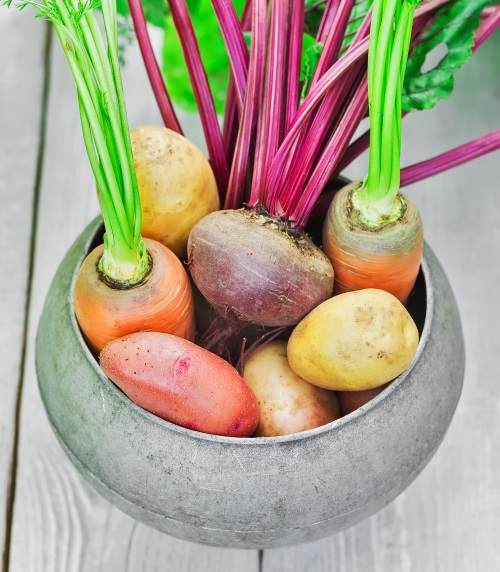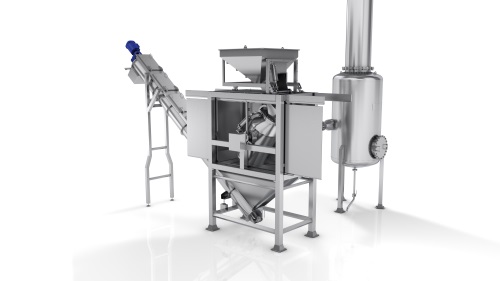tna expands its range of Florigo ultra-peel 3 steam peeling solutions for potatoes, baby carrots and other vegetables.
The range has three steam vessel designs to deliver peel efficiency, yield and uniform skin removal, while cutting average maintenance costs by 50%.
There are steam peelers for large root vegetables like potatoes for French fries and vessels with centrally controlled steam inlets for smaller, irregular shaped produce to enable uniform steam coverage.
There are also split vessel designs for raw materials with high level of water content, such as baby carrots.
Carel Pfaff, group product manager – processing, tells Food News International more.
FNI: How does steam peeling work?
Pfaff: Steam peeling is a common technique to loosen the skin from products such as potatoes, carrots, beets and other root vegetables.
A steam peeler essentially consists of a weigh hopper, hollow steel vessel with a valve for product charge and discharge, connections for steam supply and steam discharge (expansion vessel) and an auger discharge for raw material or product.
Raw materials are fed either into a rotating vessel or a static vessel with a stirring device.
There are generally two types of steam peeling processes – continuous and batch.
Batch steam peelers tend to use higher pressures of steam (1500-2000 kilopascal, or kPa) and less water than continuous steam peelers.
At these high temperatures (above 100°C), the skin of the product cooks within 15 to 30 seconds.
The pressure is then instantly released, which causes the water under the surface layer to immediately boil off, causing the skin to peel.
The peel is then loosened on the raw material.
Any remaining traces of peel are removed in either a brushing machine or a dry de-skinner rotating drum with an auger.
FNI: How is steam peeling compared to other known industrial peeling methods?
Pfaff: Compared to other peeling techniques, steam peeling typically generates lower peel losses and a smooth product surface.
However, which method is best will ultimately depend on the product, the production capacities and what kind of finish is required.
For example, steam peeling is ideal for raw materials with non-uniform shapes as the steam can remove the skin much more effectively than abrasive peeling, which often results in a rougher surface and a higher peel loss.
Steam peelers are also great for high capacity production lines (6-30t/h) such as French fry productions, which would typically require multiple abrasive peelers to handle these kind of volumes.
Safety is very important when running a steam peeler.
As temperatures of the steam vessel can reach as much as 200ºC, there are a number of safety mechanisms, including mechanical keys that would not allow access to the vessel to eliminate any risk or danger of an accident.
FNI: How is minimum peel loss achieved with the Florigo ultra-peel 3?
Pfaff: The machine provides processors with advanced control over steam time, steam pressure and filling levels.
These parameters are important as each raw material reacts differently to steam exposure, depending on the thickness of the skin, size and the shape of the product.
Our processing engineers have analyzed the behaviors of various materials and concluded that there is a need for different steam vessel designs to minimize the peel loss per product. With our Florigo ultra-peel SSC 3 range, we now offer tailored vessel designs that not only deliver optimum steam distribution, but that also answer to the specific handling needs of each desired steamed product.
Each product is exposed evenly to the steam for a homogenous peeling result and minimum peel loss with the help of a weigh hopper, which takes care of the fast and correct filling of the vessel.
For potatoes, we offer a vessel design with a side-mounted steam basket, instead of the centrally mounted steam basket, to ensure there is enough free space for the potatoes to rotate inside the drum.
For baby carrots, on the other hand, we designed a vessel with a large central basket that is fitted with mixing plates because the product is packed more tightly and does not roll around as much.
FNI: What should processors take note of when working with steam peeling systems to ensure optimal production?
Pfaff: An effective steam peeler should be able to remove as little of the underlying material as possible but still achieve a smooth and clean surface.
Typically, peel loss for steam peelers should not be more than 6%, however, ultimately this will depend on the type of product.
For example, on thick skin the steam time is longer, while on thinner skin the steam time is decreased to avoid over-peeling.
The type of product will also dictate what vessel design is required.
Baby carrots have a different shape, skin thickness and steam exposure reaction compared to potatoes or beet roots, for example.
Ensuring that the products’ surfaces receive equal exposure to the steam is important for excellent peel results.
In addition, vessel designs with large openings will ensure fast filling and discharge, increasing the number of batches per hour.
Another key consideration for processors should be the maintainability of the system and cost attached to it.
Steam peelers are heavy-loaded machines that often require a higher number of spare parts than other pieces of equipment in the line.
A steam peeler that features a robust design with few moving parts is key to increase uptime and ensure processors get the highest return on investment over the lifetime of the equipment.













